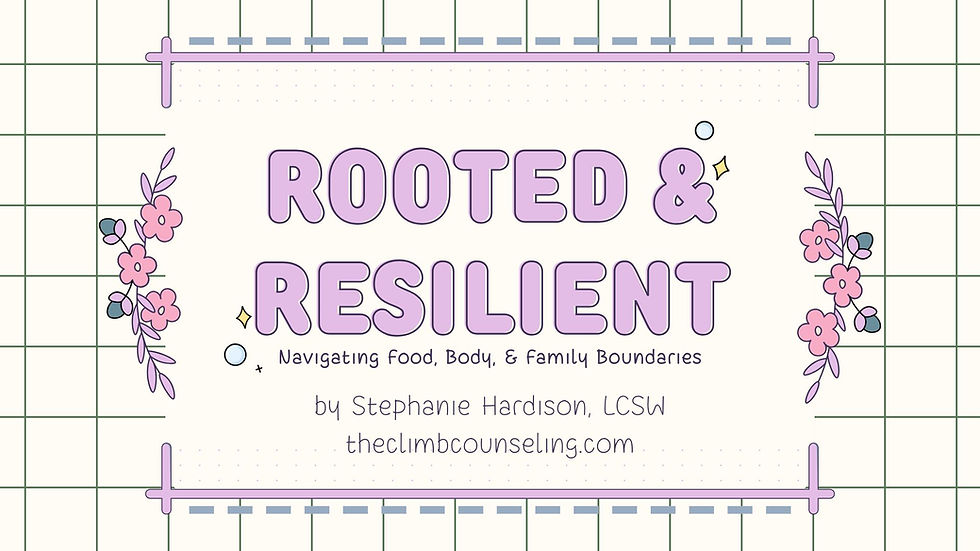Exploring Inclusive Therapy Methods for Everyone
- theclimbcounseling

- Jul 31
- 3 min read
Therapy is a vital resource for mental health and well-being. However, traditional therapy approaches may not always address the diverse needs of all individuals. Inclusive therapy methods aim to create a welcoming and supportive environment for everyone, regardless of background, identity, or ability. This blog post explores various inclusive therapy methods, their benefits, and practical ways to implement them.
Understanding Inclusive Therapy Methods
Inclusive therapy methods focus on recognizing and respecting the unique experiences of each person. These approaches consider factors such as culture, gender identity, sexual orientation, disability, and socioeconomic status. The goal is to provide equitable mental health support that meets people where they are.
Some key principles of inclusive therapy include:
Cultural Competence: Therapists educate themselves about different cultures and avoid assumptions.
Accessibility: Therapy spaces and materials are designed to accommodate physical and sensory needs.
Affirmation: Therapists validate clients' identities and experiences without judgment.
Collaboration: Clients are active participants in their therapy process.
By integrating these principles, therapists can foster trust and openness, which are essential for effective treatment.

Practical Inclusive Therapy Methods
Implementing inclusive therapy methods involves specific strategies that therapists and mental health professionals can use. Here are some practical examples:
1. Use of Affirmative Language
Language shapes how clients feel about themselves. Using affirming and respectful language helps clients feel seen and valued. For example, asking clients their preferred pronouns and using them consistently shows respect for their gender identity.
2. Flexible Communication Styles
Not everyone communicates in the same way. Some clients may prefer verbal communication, while others might find writing or art more comfortable. Therapists can offer multiple ways to express thoughts and feelings, such as journaling, drawing, or using digital tools.
3. Trauma-Informed Care
Many individuals have experienced trauma that affects their mental health. Inclusive therapy methods incorporate trauma-informed care by creating a safe space, avoiding retraumatization, and empowering clients to control their healing process.
4. Accessibility Accommodations
Therapy should be accessible to people with disabilities. This can include providing wheelchair-accessible spaces, offering sessions via video calls for those with mobility challenges, or using assistive technologies for clients with hearing or vision impairments.
5. Incorporating Cultural Practices
Some clients find comfort in cultural or spiritual practices. Therapists can integrate these elements into therapy when appropriate, such as mindfulness techniques rooted in cultural traditions or allowing space for clients to share their cultural narratives.

Benefits of Inclusive Therapy Methods
Inclusive therapy methods offer numerous benefits for both clients and therapists:
Improved Client Engagement: When clients feel understood and respected, they are more likely to engage actively in therapy.
Better Outcomes: Tailoring therapy to individual needs can lead to more effective treatment and faster progress.
Reduced Stigma: Inclusive approaches help normalize diverse identities and experiences, reducing shame and isolation.
Enhanced Therapist Competence: Therapists who practice inclusivity develop greater cultural humility and professional growth.
These benefits contribute to a more equitable mental health system where everyone has the opportunity to thrive.
How to Find Inclusive Therapy Services
Finding the right therapist who practices inclusive therapy methods can be challenging. Here are some tips to help you locate supportive and affirming mental health professionals:
Research Providers: Look for therapists who explicitly mention inclusivity, cultural competence, or specific populations they serve.
Ask Questions: During initial consultations, ask about their experience with diverse clients and how they accommodate different needs.
Check Credentials: Verify that the therapist has relevant training in inclusive practices or specialized certifications.
Use Trusted Resources: Websites like inclusive therapy services offer directories and information about therapists committed to inclusivity.
Seek Recommendations: Reach out to community groups or support networks for referrals.
Taking these steps can help ensure you receive therapy that respects and supports your unique identity.

Moving Forward with Inclusive Therapy
Inclusive therapy methods are essential for creating mental health care that truly serves everyone. By embracing diversity and adapting to individual needs, therapists can build stronger connections and foster healing. Whether you are a client seeking support or a professional aiming to improve your practice, understanding and applying inclusive therapy principles is a meaningful step forward.
Remember, mental health care should be a place where all people feel safe, respected, and empowered to grow. Inclusive therapy methods make this vision possible.



Comments